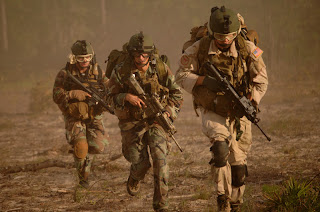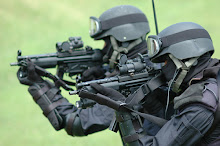
The new top commander in Afghanistan is talking up a weapon that has been kept in the shadows for years - special operations missions to kill or capture key insurgents - to try to convince skeptics the war can be won.
More than previous commanders, Gen. David Petraeus has been releasing the results of special operations missions - 365 militant leaders killed or captured in the last 90 days, another 1,031 rank-and-file insurgents killed and 1,335 detained - to demonstrate the Taliban and their allies are also suffering losses as NATO casualties rise.
Accentuating the positive is part of Petraeus' media style, developed when he commanded U.S. forces in Iraq and was widely credited with helping turn the tide in that war.
Those skills are part of what the White House knew it needed when President Barack Obama selected the four-star general in July to replace Gen. Stanley McChrystal, after remarks critical of the administration appeared in Rolling Stone magazine.
Since taking command, Petraeus has used a series of high-profile media interviews to try to reverse the wave of pessimism about the war, especially within Congress and the American public.
Playing up missions by special operations forces - Navy SEALs, Delta Force, Army Rangers and Green Berets - offers a way to demonstrate that the U.S. and its NATO partners are taking the fight to the Taliban.
Petraeus has shared key heretofore classified data with reporters at a level of detail that surprised many U.S. officials here and in Washington.
A senior official in Kabul downplayed the notion that publicizing these details is calculated to win public support, saying it simply highlights one of the war's successes. The official spoke on condition of anonymity to discuss the commander's strategy.
Special operations missions are now at their highest tempo, with nearly 3,000 carried out between May and August, according to officials here.
U.S. officials here are sensitive to the suggestion that Petraeus is using the spec-ops successes for public effect, perhaps because it harks back to the largely discredited body counts of the Vietnam war.
But back in Washington, the release of information was warmly welcomed in some quarters, offsetting the daily drumbeat of rising U.S. casualties. At least 27 U.S. service members have been killed in the past week.
Special operations troops have been in Afghanistan since the conflict began in 2001, working with the anti-Taliban Northern Alliance to drive the Taliban from power after the Sept. 11, 2001 terror attacks in the United States and later to pursue al-Qaida leaders.
Last fall, McChrystal, who commanded special operations forces in Iraq, stepped up the tempo, broadening their mission to include killing or capturing midlevel commanders in the Taliban and their allies in the Haqqani network.
What's new is that Petraeus and his aides are talking about it.
By highlighting their successes, Petraeus could earn bankable political capital that he will need if he recommends that Obama slow the drawdown of U.S. troops that the president promised will begin next July.
This does not mean that Petraeus is shifting emphasis from traditional counterinsurgency strategy - clearing territory, holding it, building on it, and then turning it over to the Afghan government.
In an interview Tuesday with The Associated Press and two other news organizations, Petraeus spoke of spec-ops successes, but added: "You don't kill or capture your way out of an industrial strength insurgency."
However, demonstrating progress is difficult in a war fought in hundreds of small, scattered engagements, where frontlines do not move and where cities do not fall.
That's where the spec-ops raids come in. The mystique of elite, highly trained commandos swooping down on an unsuspecting Taliban leader in the dead of night plays well back home, especially at a time when much of the news from Afghanistan focuses on rising American deaths and frustration with the Afghan government.
Heavy use of special operations forces is not without risk. Afghans from President Hamid Karzai to lowly village elders complain night raids offend Afghan culture and turn the population against the international coalition.
Vice Admiral Bill McCraven, who heads up the U.S. Joint Special Operations Command Forward, traveled to a small village in Gardez province to apologize to Afghan elders, after his troops killed two armed men during a nighttime raid last February. The elders claimed three women died in the crossfire.
A U.S. defense official here says one special operations task force recorded no shots fired in 973 out of 1,225 missions in the 12 months ending in August. The targets simply gave up without a fight. The official added up to 10 Afghan special forces troops take part in each raid, often in the lead, when the force reaches the target.
The official spoke on condition of anonymity to describe classified operations.
U.S. officials believe the increased operational tempo by such forces over the past year has begun to bite into the insurgent network in the central part of Helmand province, a southern area that has seen some of the bloodiest fighting of the past two years.
U.S. intelligence has tracked a breakdown in regular communications between local commanders in Helmand and their leadership in Quetta, in the border region of Pakistan, according to defense officials who spoke on condition of anonymity to discuss matters of intelligence.
There is anecdotal evidence, the officials say, that resentment is building in the midlevel ranks of the Taliban, aimed at the top commanders who are safely ensconced in Quetta or in the North Waziristan area of Pakistan.
Still, the senior U.S. official in Kabul concedes spec-ops forces have not yet reversed the Taliban's momentum nationwide.
There's progress in some areas, he said, but "we clearly need to do more in others."
(www.military.com)
More than previous commanders, Gen. David Petraeus has been releasing the results of special operations missions - 365 militant leaders killed or captured in the last 90 days, another 1,031 rank-and-file insurgents killed and 1,335 detained - to demonstrate the Taliban and their allies are also suffering losses as NATO casualties rise.
Accentuating the positive is part of Petraeus' media style, developed when he commanded U.S. forces in Iraq and was widely credited with helping turn the tide in that war.
Those skills are part of what the White House knew it needed when President Barack Obama selected the four-star general in July to replace Gen. Stanley McChrystal, after remarks critical of the administration appeared in Rolling Stone magazine.
Since taking command, Petraeus has used a series of high-profile media interviews to try to reverse the wave of pessimism about the war, especially within Congress and the American public.
Playing up missions by special operations forces - Navy SEALs, Delta Force, Army Rangers and Green Berets - offers a way to demonstrate that the U.S. and its NATO partners are taking the fight to the Taliban.
Petraeus has shared key heretofore classified data with reporters at a level of detail that surprised many U.S. officials here and in Washington.
A senior official in Kabul downplayed the notion that publicizing these details is calculated to win public support, saying it simply highlights one of the war's successes. The official spoke on condition of anonymity to discuss the commander's strategy.
Special operations missions are now at their highest tempo, with nearly 3,000 carried out between May and August, according to officials here.
U.S. officials here are sensitive to the suggestion that Petraeus is using the spec-ops successes for public effect, perhaps because it harks back to the largely discredited body counts of the Vietnam war.
But back in Washington, the release of information was warmly welcomed in some quarters, offsetting the daily drumbeat of rising U.S. casualties. At least 27 U.S. service members have been killed in the past week.
Special operations troops have been in Afghanistan since the conflict began in 2001, working with the anti-Taliban Northern Alliance to drive the Taliban from power after the Sept. 11, 2001 terror attacks in the United States and later to pursue al-Qaida leaders.
Last fall, McChrystal, who commanded special operations forces in Iraq, stepped up the tempo, broadening their mission to include killing or capturing midlevel commanders in the Taliban and their allies in the Haqqani network.
What's new is that Petraeus and his aides are talking about it.
By highlighting their successes, Petraeus could earn bankable political capital that he will need if he recommends that Obama slow the drawdown of U.S. troops that the president promised will begin next July.
This does not mean that Petraeus is shifting emphasis from traditional counterinsurgency strategy - clearing territory, holding it, building on it, and then turning it over to the Afghan government.
In an interview Tuesday with The Associated Press and two other news organizations, Petraeus spoke of spec-ops successes, but added: "You don't kill or capture your way out of an industrial strength insurgency."
However, demonstrating progress is difficult in a war fought in hundreds of small, scattered engagements, where frontlines do not move and where cities do not fall.
That's where the spec-ops raids come in. The mystique of elite, highly trained commandos swooping down on an unsuspecting Taliban leader in the dead of night plays well back home, especially at a time when much of the news from Afghanistan focuses on rising American deaths and frustration with the Afghan government.
Heavy use of special operations forces is not without risk. Afghans from President Hamid Karzai to lowly village elders complain night raids offend Afghan culture and turn the population against the international coalition.
Vice Admiral Bill McCraven, who heads up the U.S. Joint Special Operations Command Forward, traveled to a small village in Gardez province to apologize to Afghan elders, after his troops killed two armed men during a nighttime raid last February. The elders claimed three women died in the crossfire.
A U.S. defense official here says one special operations task force recorded no shots fired in 973 out of 1,225 missions in the 12 months ending in August. The targets simply gave up without a fight. The official added up to 10 Afghan special forces troops take part in each raid, often in the lead, when the force reaches the target.
The official spoke on condition of anonymity to describe classified operations.
U.S. officials believe the increased operational tempo by such forces over the past year has begun to bite into the insurgent network in the central part of Helmand province, a southern area that has seen some of the bloodiest fighting of the past two years.
U.S. intelligence has tracked a breakdown in regular communications between local commanders in Helmand and their leadership in Quetta, in the border region of Pakistan, according to defense officials who spoke on condition of anonymity to discuss matters of intelligence.
There is anecdotal evidence, the officials say, that resentment is building in the midlevel ranks of the Taliban, aimed at the top commanders who are safely ensconced in Quetta or in the North Waziristan area of Pakistan.
Still, the senior U.S. official in Kabul concedes spec-ops forces have not yet reversed the Taliban's momentum nationwide.
There's progress in some areas, he said, but "we clearly need to do more in others."
(www.military.com)

No comments:
Post a Comment